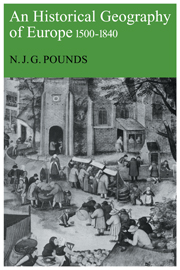Book contents
- Frontmatter
- Contents
- List of maps and diagrams
- List of abbreviations
- Preface
- 1 Europe in the early sixteenth century
- 2 The population of Europe from the sixteenth to the early nineteenth centuries
- 3 The pattern of cities
- 4 Agriculture from the sixteenth to the nineteenth centuries
- 5 Manufacturing and mining
- 6 The pattern of trade
- 7 Europe on the eve of the Industrial Revolution
- Notes
- Index
3 - The pattern of cities
Published online by Cambridge University Press: 04 August 2010
- Frontmatter
- Contents
- List of maps and diagrams
- List of abbreviations
- Preface
- 1 Europe in the early sixteenth century
- 2 The population of Europe from the sixteenth to the early nineteenth centuries
- 3 The pattern of cities
- 4 Agriculture from the sixteenth to the nineteenth centuries
- 5 Manufacturing and mining
- 6 The pattern of trade
- 7 Europe on the eve of the Industrial Revolution
- Notes
- Index
Summary
There have been three periods in the history of Europe when the foundation and building of cities was a major preoccupation of western man. The first was in the classical period, when the Greeks and Romans developed their poleis and civitas capitals. The second occurred during the Middle Ages, roughly from the eleventh to the fourteenth centuries, and the third was associated with the industrial and commercial developments of the late eighteenth and nineteenth centuries. Each built on the settlement pattern which had preceded it. Medieval urbanism derived in part from classical. Most ancient cities in western and southern Europe survived the Dark Ages, and were supplemented by the new towns of the Middle Ages. Only in central and eastern Europe was there no tradition of classical urbanism on which to build. The urban development associated with the Industrial Revolution was similarly established on a foundation of medieval urbanism. It assumed two directions, first a selective growth amongst the older towns, some of which found themselves well placed for a new role in industry. Many small and obscure medieval towns, such as Essen and Dortmund; Berlin, Chemnitz and Plzen, came into prominence during the period of industrial growth and grew in the nineteenth century to be giants amongst the cities of Europe. Other cities grew during this period from village origins; such were the coal-mining towns of northern France and central Belgium; ironworking centres such as Oberhausen, Charleroi and Zabrze, and mill-towns like Elbeuf and Verviers.
Urban development in the sixteenth century
The pattern of towns in Renaissance Europe was essentially that of the later Middle Ages.
- Type
- Chapter
- Information
- An Historical Geography of Europe, 1500-1840 , pp. 116 - 157Publisher: Cambridge University PressPrint publication year: 1980



